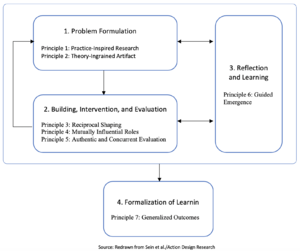Action Design Research according to Sein et al
Introduction
"Two paradigms characterize much of the research in the Information Systems discipline: behavioral science and design science. The behavioral science paradigm seeks to develop and verify theories that explain or predict human or organizational behavior. The design-science paradigm seeks to extend the boundaries of human and organizational capabilities by creating new and innovative artifacts. Both paradigms are foundational to the IS discipline, positioned as it is at the confluence of people, organizations, and technology."[1]
In many publications, essays, editorials or books the Design Science Research method is described and they aim to support researchers to conduct DSR projects for example by providing guidelines[1] or how to extend on existing design knowledge[2]. Gregor and Hevner provide guidance by describing their understanding and application of DSR concepts including:
- Appreciate the levels of artifact abstractions that may be DSR contributions
- Identify appropriate ways of consuming and producing knowledge when they are preparing journal articles or other scholarly works
- Understand and position the knowledge contributions of their research projects
- Structure a DSR article so that it emphasizes significant contributions to the knowledge base
Their focal contribution is the DSR knowledge contribution framework with two dimensions based on the existing state of knowledge in both the problem and solution domains for the research opportunity under study. In addition, they propose a DSR communication schema with similarities to more conventional publication patterns, but which substitutes the description of the DSR artifact in place of a traditional results section. [3]
Other researchers propose core dimensions of a Design Science Research (DSR) project that facilitate effective capture of the most relevant aspects of a DSR project to efficiently plan and communicate key considerations and conceptualizations of a DSR project. In this work, the authors represent six dimensions in the form of a DSR grid, a one-page visualization of the DSR project that is adjustable to the specific purpose for using the concept.[4]
Process description
Action design research is a research method for generating prescriptive design knowledge through the building and evaluating ensemble IT artifacts in an organizational setting. It deals with two seemingly disparate challenges:
- addressing a problem situation encountered in a specific organizational setting by intervening and evaluating
- constructing and evaluating an IT artifact that addresses the class of problems typified by the encountered situation
The responses requested by these two challenges result in a method that focuses on constructing, intervening, and evaluating an artifact that represents not only the researchers 'theoretical precursors and purpose but also user impact and ongoing use in context.
Problem Formulation
Description
Tasks to be performed in the problem formulation activity:
- Identify and conceptualize the research opportunity
- Formulate initial research questions
- Cast the problem as an instance of a class of problems
- Identify contributing theoretical bases and prior technology advances
- Secure long-term organizational commitment
- Set up roles and responsibilities
Examples
Further Readings
Sein, Maung K.; Henfridsson, Ola; Purao, Sandeep; Rossi, Matti; and Lindgren, Rikard. 2011. "Action Design Research," MIS Quarterly, (35: 1) pp.37-56.
Building, Intervention, and Evaluation
Description
Tasks to be performed in the building, intervention, and evaluation activity:
- Discover initial knowledge-creation target
- Select or customize BIE form
- Execute BIE cycle(s)
- Assess need for additional cycles, repeat
Examples
Further Readings
Sein, Maung K.; Henfridsson, Ola; Purao, Sandeep; Rossi, Matti; and Lindgren, Rikard. 2011. "Action Design Research," MIS Quarterly, (35: 1) pp.37-56.
Reflection and Learning
Description
Tasks in the reflection and learning activity:
- Reflect on the design and redesign during the project
- Evaluate adherence to principles
- Analyze intervention results according to stated goals
Examples
Further Readings
Sein, Maung K.; Henfridsson, Ola; Purao, Sandeep; Rossi, Matti; and Lindgren, Rikard. 2011. "Action Design Research," MIS Quarterly, (35: 1) pp.37-56.
Formalization of Learning
Description
- Tasks to be performed in the formulation of learning activity:
- Abstract the learning into concepts for a class of field problems
- Share outcomes and assessment with practitioners
- Articulate outcomes as design principles
- Articulate learning in light of theories selected
- Formalize results for dissemination
Examples
Further Readings
Sein, Maung K.; Henfridsson, Ola; Purao, Sandeep; Rossi, Matti; and Lindgren, Rikard. 2011. "Action Design Research," MIS Quarterly, (35: 1) pp.37-56.
References
- ↑ 1.0 1.1 Hevner AR, March ST, Park J and Ram S (2004) Design Science in Information Systems Research. MIS Quarterly 28(1), 75-105.
- ↑ vom Brocke, J., Winter, R., Hevner, A., Maedche, A. (2020), Accumulation and Evolution of Design Knowledge in Design Science Research – A Journey Through Time and Space, in: Journals of the Association for Information Systems (JAIS), 2020, forthcoming (ABDC_2016: A*; ABS: 4; ISI: 3.487; ISI: 2.109; VHB_3: A).
- ↑ Gregor S and Hevner AR (2013) Positioning and Presenting Design Science Research for Maximum Impact. MIS Quarterly 37(2), 337-55.
- ↑ vom Brocke, J., Maedche, A. (2019), The DSR Grid: Six Core Dimensions for Effectively Planning and Communicating Design Science Research Projects, in: Electronic Markets, Volume 29, Issue 3, pp 379–385 (ABDC: A; ABS: 2; ISI: 2.121; VHB: B).
